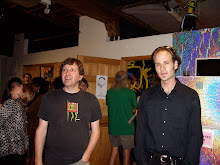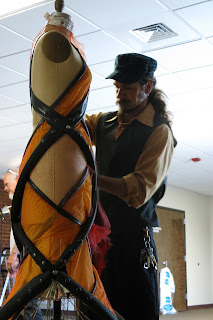Artists
Statement
Some Thoughts
On Meanings Of Forbidden Fruit Dress
By Travis Cohn
May 11, 2013
I
should start out by saying that I did not begin this dress with any particular
conscious themes or motives in mind. I just approached it as a personal design
challenge. Any meanings sorted out below are in fact what ‘issued forth’ during
the subsequent development of the piece. But as it seemed to evolve into
something of its own, so I thought it seemed worth mentioning.
ACCEPTING THE CHALLENGE
I
have to say that I accepted this challenge somewhat in spite of myself; in
spite of my most prudent conscious objections and warnings. After fully
dismissing the project as fun, but not something I had the time for, I was
abruptly awoken late in the night by my own stimulated imagination; a certain,
mysterious and avaricious part of me, it seems, which could not resist the
temptation of this challenge. Indeed, it seems my (crafty) ‘muse’ had used the
vulnerability of sleep to got the better of me. And so I realized, with some
chagrin, that I was ‘in’.
And
that challenge, for me, as I saw it, was to somehow mold tire rubber (my
beloved chosen medium of 10 years) to another, very different beloved form, the
human female form, to manifest in the traditional form of a dress…
As
I lay there, eyes ‘wide shut’, my mind took to the task with a vengeance. At
this initial stage, I was approaching it purely formally, mentally tracing the
subtle curves of the human figure åwith those of of the serpentine tire,
searching for paths on which these two could walk gracefully together. Once I
had found these pathways along and around the landscape of the body, this
network, this tire armature was to be the skelaton of the dress. It would be up
to me to draw out and utilize whatever qualities and associations of tires lent
themselves to the talk, in subsequent stages.
And
indeed, as I began to experiment, and let the tires interact with other, new
additional materials (namely netted produce bags), the dress rapidly and
increasingly began to blossom into a life of its own, which I had no choice but
to follow faithfully to its own end, discovering what surprises were held
within as I went.
THE ‘ALLURE’ OR NET PRODUCE BAGS
While
tires served as a structural role in this dress (acting as kind of a
‘trellis’), it actually came to play a more supportive role to another
material, new for me; netting produce bags. This casting choice was also quite
intuitive; I have been collecting these bags for several years, waiting for
their right application. I just followed a strong hunch that this dress might
somehow be their big chance to enter into a new dialogue; the body somehow
seemed like rich soil for this material to speak.
Indeed,
I have always found these netted bags that certain produce are presented in
(namely citrus fruits, but also onions and garlic) to be mysteriously
captivating, attractive, and indeed subtly erotic. The sight of rounded forms,
bulging out against this thin veil that seems to barely contain them
(particularly garlic, actually), can only be seen as stimulating and inviting.
And
of course, invitation and allure are ‘part and parcel’ of product packaging,
well beyond their mere delivery (but also in addition to it).
Perhaps
it is this simultenaity of a practical need to deliver a good, with a secondary
aesthetic function to ‘market’ it, that arrests my interest. Here, perhaps, we
arrive solidly in the earthly domain of design. And is it really any new leap
to look over the netted shoulder of these bags of fruit, to the long, long
history of humanity’s adornment of our own bodies? The fact that the fig leaf
is woven into (even somewhat central to) our Judeo-Christian creation myth,
cannot be overlooked…
ROOTS IN OLD TESTAMENT?
Indeed,
while my choice of this material was purely intuitive, as I moved deeper into
the project, I could not help but notice it quickly taking on strange biblical
connotations…
The
story of humanity’s fall from innocence, treachery, seduction, fall from
innocence, all bound up in our (somewhat tragic) central creation myth…and
stragely, these timeless themes seem some how bound up in the dress’s design
(at least in my own eyes).
The snake like tires, winding around the tree of the body.
The many X’s (in the dress’ design, which is a series of triple x’s…and the
netting, which is comprised of a field of red x’s), which forbid, yet as a
field, invite… Bow, (a common feature on dresses) a simultaneneous securing and
invitation to unravel.
All of these strange ideas seem to found, circling around this
dress, like the helix of tires that enshrouds the body.
What’s in it? What does it all mean? I’m not sure. Like any
good art piece, I don’t think Forbidden Fruit Dress provides any answers. But I
do hope that at least it provokes some interesting questions about the body,
the psyche, and the complexities of desire and sexuality that both are heir to.
THE SEDUCTIVE MUSE
Finally,
perhaps in some ways, this aspect of seduction and sexuality mimics the
creative process itself. Is it a coinidence that (at least in the canonical
world of traditionally male writers and artists) the mythical figure of the muse is gendered as feminine, and in this case, it seems,
seductive…
That
is to say that, for me at least, sometimes a material, or image, idea, a project,
strikes the eye, like a bag of veiled fruit, ‘bursting at the seams’ (as it
were- pun all too aptly intended).
You can’t quit see inside of it, but you have the vague
sense that there is something of value waiting inside, that is worth exploring,
possibly consummating.
Such seems to have been the case with the creation of this
dress.
I would like to thank
the following:
The staff of FRANK
Gallery
for the gracious patience in working
with me on this technically very challenging piece.
Nicole Hogan,
for her astute
feedback on the dresses design, and for modeling it so deftly
My Mother Edie
Cohn,
for her practical whit, and dependable
assistance in carrying off the runway event.
The Scrap Exchange,
for their awesome
support of me, and this project, and for the good use of
the Design Center,
and the lovely dress form, who resides therein.














+Dog.jpg)
































+(cropped.jpg)



+(cropped.jpg)
.jpg)




























